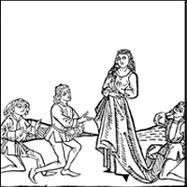Courtly love was a highly codified art form – it was formulaic and involved ‘rules’ of behaviour and speech. This protocal became known as “Fin’ Amor.” Here, a 12th century writer lays down the law…. Incidentally, this set of “rules” was widely accepted as satire – but to every satire there is truth!
The Rules of Love
from Book II of De Arte Honesti Amandi by Andreas Capellanus
(written approx. 1186 – 1190)
1. The state of marriage does not properly excuse anyone from loving.
2. He who does not feel jealousy is not capable of loving.
3. No one can love two people at the same time.
4. It is well-known that love is always either growing or declining.
5. Whatever a lover takes against his lover’s will has no savor.
6. A male does not fall in love until he has reached full manhood.
7. A mourning period of 2 years for a deceased lover is required of the surviving partner.
8. No one should be prevented from loving except by reason of his own death.
9. No one can love unless they are compelled by the eloquence of love.
10. Love is accustomed to be an exile from the house of avarice.
11. It is unseemly to love anyone whom you would be ashamed to marry.
12. A true lover does not desire the passionate embraces of anyone else but his beloved.
13. Love that is made public rarely lasts.
14. Love easily obtained is of little value; difficulty in obtaining it makes it precious.
15. Every lover regularly turns pale in the presence of his beloved.
16. On suddenly catching sight of his beloved, the heart of the lover begins to palpitate.
17. A new love drives out the old.
18. A good character alone makes someone worthy of love.
19. If love lessens, it soon fails and rarely recovers.
20. A man in love is always fearful.
21. The feeling of love is always increased by true jealousy.
22. When a lover feels suspicious of his beloved, jealousy, and with it the sensation of love, are increased.
23. A man tormented by the thought of love eats and sleeps very little.
24., Everything a lover does ends in the thought of his beloved.
25. A true lover considers nothing good but what he thinks will please his beloved.
26. Love can deny nothing to love.
27. A lover cannot have too much of his beloved’s consolations.
28. A small supposition compels a lover to suspect his beloved of doing wrong.
29. A man who is troubled by excessive lust does not usually love.
30. A true lover is continually and without interruption obsessed by the image of his beloved.
31. Nothing forbids one woman being loved by two men, or one man by two women.
Think that the rules of courtly love don’t apply to our modern lives? Think of the last romance book you read, a romantic movie you’ve seen, the storyline of famous authors. How many modern women are waiting for their own ‘prince charming’ or ‘knight in shining armor’? Know the story of Tristan and Isolde? How about King Arthur and his Gueneviere? The delicate games of courtship played out in a Jane Austin novel…?
This is the heritage of the medieval troubadour. Their stylized idealization of women and the rules of courtship in her adoration, have shaped today’s ideals of a romantic ideal. The knightly code of honor is based in this.
